
An old photograph. It was 1983 in the Summer Palace. I saw this couple, the man with the oars, the woman with an umbrella. I waited for the man to row. When the oar hit the water, there was a splash. It was what I was anticipating. This is one of my favorite photographs.

At Karnak in Luxor, Upper Egypt. I was standing in the navel of the temple. I read that the temple architecture was patterned after figure of a human being. I was testing the vibration of different parts of the body. The are books about the influence of Egyptian temple architecture on the Gothic churches in Europe.
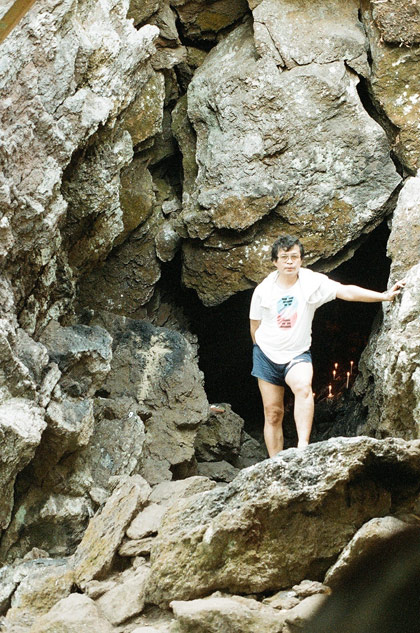
1986. Outside the Cave of Jacob in Mount Banahaw, Philippines. The mountain is the most sacred in the country for pilgrims. You descend through a very narrow entrance that takes you to a small altar beside a pool. You make an offering and then lower yourself in the water 3 times as a ritual prayer. I’ve entered the cave twice. It is one of the grottoes in the sacred mountain. A pilgrim lights a candle at each spot starting from the waterfall where s/he is washed in preparation for the ascent to the mountain. There are at least 20 religious groups — “cults”? — headed by women/priestesses. One time, I was standing on a rock in Kinabuhayan/Resurrection, a young woman — a priestess — approached me and stood just about 2 or 3 feet away, without saying a word. When she spoke, she answered the question in my mind. It was about the denudation of the forest in the area.
Every time I have the opportunity, I make a trip to the mountain.
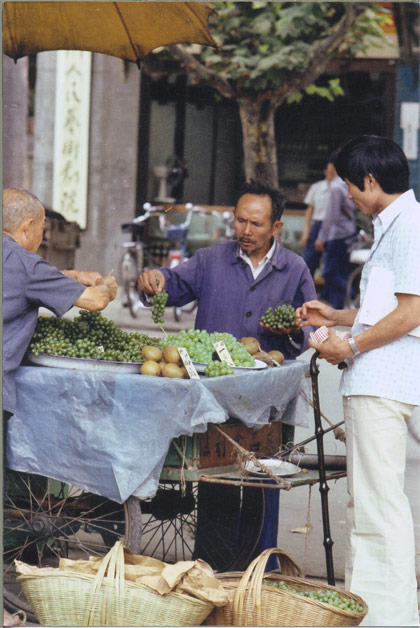
Sichuan grape vendor: Walking down People’s Road South to the Friendship Store, where Chairman Mao’s giant statue extends a salute, you’ll see common scenes: people pulling carts of night soil, bicycles transporting chickens or pigs, Chinese learning to speak English, vendors selling produce, a stall where you can rent comics. This was in 1983. Nowadays, you’ll see people hanging around internet cafes almost all night. When I was in Huangshan in 2007, I used to go to the internet cafe early at 4 ot 5, but even at that time, it was crowded.
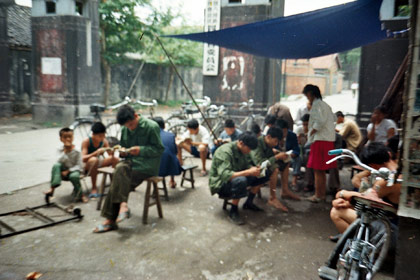
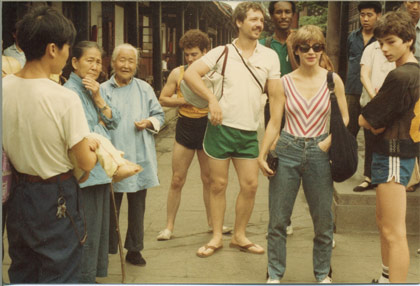
The American Wu-Shu delegation visited a Buddhist Temple. The nuns were amused by the attire of the foreigners. “Where did your clothes go?” asked the Chinese woman.

It was my first time in Egypt. There were touts announcing rides on camels. I took this photo at the moment the rider raised his whip. My grandchildren asked me to have a photo of myself riding a camel. It was not until my 3rd trip to Giza that I finally rode one. But the photo was blurred because the battery of my camera began to fail. It was actually a short ride, nothing momentous about it. I got on the camel (it was sitting on the ground), it stood up rather ungracefully, I kind of tottered on its back and held on to the saddle, and the gentle but smelly beast took a few steps. On order of the trainer, it got down — again awkwardly — and I got off. . That was it. We did not even get to say hello to each other. My host Hana paid him I do not know how much. Actually, I spent more time on a donkey’s back riding through the Valley of the Kings. It was a memorable and vivid experience. When I think about it, I can still feel my sore bottom.

Scotland is one of the most beautiful countries I have ever been to. It is a place I have never tired of. There are lochs and monroes (mountains of a certain height) and stone circles that are striking and awesome. If you are favored by the goddess, you’ll even have a brief glimpse of the Loch Ness Monster. Scotland is a photographer’s dream subject. To me, it was also a place of power. When I did qigong there, especially in the stone circles, I felt a strong vibration. On my oath, I can swear that I took a photo of Nessie, but again, my camera did not work so I have no proof of its existence. There are many more spots there I haven’t seen even if I have visited the country a few times. Perhaps in the next lifetime I will remember to adventure up in the Highlands and farther north among the stone circles during the solstices and equinoxes. I have friends there — Gordon Faulkner and Maria. Gordon is a master of Medical Qigong and Tai chi chuan. It helps too that he has a large collection of excellent wine in his cellar.
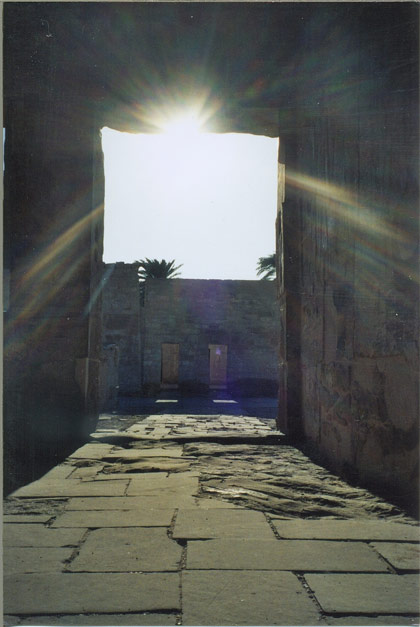
I can’t remember now where in Upper Egypt I took this photograph with the sunburst through the ruins of a temple. Perhaps it was at Dendera or Abydos. It was a couple of hours near Luxor. Tourists in buses and taxis were escorted by the military at the time because of a bloody episode involving terrorists. The route passed Nag Hamadi, the village where the Gnostic Gospels were discovered by the shepherd Muhammad. I began taking serious interest in the Gospels — of Mary Magdalene, Thomas, Judas — when I returned home.
At Dendera, you’ll see incredible etchings on the walls that look like a helicopter and a battery, among other things. There’s also an ancient zodiac on the ceiling. If you are lucky, you may even bump into a Guardian of the Temple. He will look ordinary, perhaps he will even ask you for bakshish (gratuity, donation or bribe). But if you resonate with each other (gan ying in Chinese), he will show you some of the mysterious techniques of healing and power that have been kept secret for millenniums. I have received an invitation to visit friends in Cairo but with the political situation, I can only say next time.

Hong Cun Village was lifted from obscurity by the movie “Crouching Tiger, Hidden Dragon.” At the time I visited in the Fall of 2006 there were many art students painting the scene from different angles. Cindy Zhou was our tourist guide and translator for Anhui, Huangshan, and Tunzi. A year later I was surprised to see her at the airport when I landed with David Verdesi in Tunzi. I was even more surprised when a year later she wrote to ask if I was the man in the picture with the old master, her teacher’s teacher. See photo of the master in the essay “Thunder Path in Huangshan.”
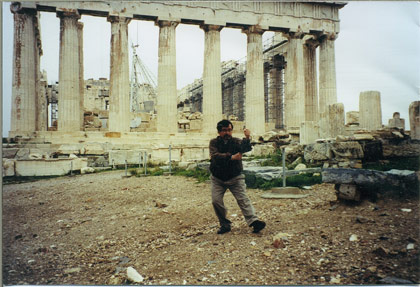
I love to do Tai Ji in different places to experience the Qi. In the Parthenon, the Qi was very powerful. Not so in the Eiffel
Tower. I’ve done Tai Ji in Istanbul beside the Blue Mosque and the Bosphorus, in Huangshan at dawn, and a few other places like the Tor or the Abbey. I’ve had mystical experiences in Stonehenge, Giza, Karnak, among other places. There is no secret to attaining to a strange frequency that feels like one has entered a different dimension. It seems all one has to do is surrender and keep still. Anyway, that’s what I did. Perhaps I received a blessing from the spirits of the place.
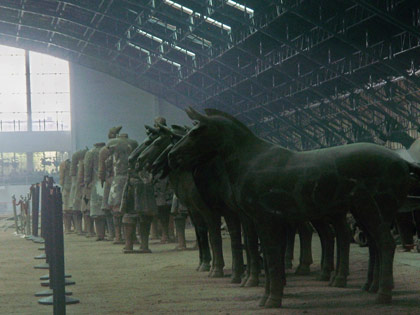
The terra cotta warriors, larger than life, are famous. Not so the terra cotta horses in back of the burial ground in Xian. In other places, the terra cotta statues were in miniature. As small a foot. The horses in Xian were life-size. Maurice Cotterell, a scientist, wrote a book about the symbolic meanings of the hand gestures of the terra cotta warriors and related them to the mysterious figures in Mexico and Bolivia.
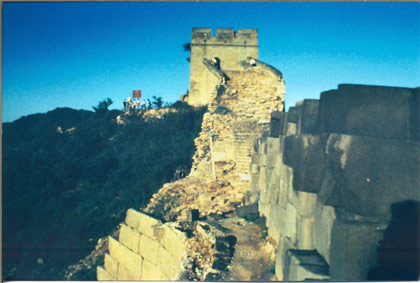 It was in the summer of 1983. I was with new friends. We had just spent a month training in wu-shu, contemporary martial arts, in Chengdu, Sichuan. We decided to split from the main delegation and go to Beijing. We hired a taxi to pick us up at about 4 in the morning to take us to the Great Wall at Badaling. Some spots were in ruins at the time. Arriving at dawn, we witnessed the sunrise. There were a few stragglers among the parapets. The area was practically empty of tourists. Nowadays, you won’t find privacy in the Great Wall. There would be 5 to 10 people walking elbow to elbow up to the summit.
It was in the summer of 1983. I was with new friends. We had just spent a month training in wu-shu, contemporary martial arts, in Chengdu, Sichuan. We decided to split from the main delegation and go to Beijing. We hired a taxi to pick us up at about 4 in the morning to take us to the Great Wall at Badaling. Some spots were in ruins at the time. Arriving at dawn, we witnessed the sunrise. There were a few stragglers among the parapets. The area was practically empty of tourists. Nowadays, you won’t find privacy in the Great Wall. There would be 5 to 10 people walking elbow to elbow up to the summit.
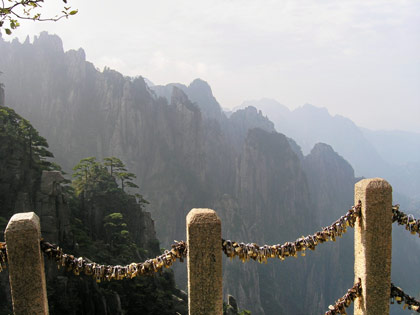
The photo shows a chain with padlocks. They were part of a tradition among lovers who attached the padlock to the chain as a symbol of their promise to love each other forever. I understand that they threw the key down the valley. I am not cynical, but I often recite a quote I read somewhere that it’s the triumph of hope over experience. Somebody apparently has a thriving business up in the mountain.

With students under an ancient willow tree in Maui, Hawaii. I used to teach at the acupuncture school there in the late 90s. Arguably the most beautiful island in the chain, Maui has many power vortices. There is the dormant volcano Haleakala, the needle in Iao Valley, the different beaches (with pink, black and green sand) and waterfalls and the remote spots that are not reached by tourists.
The island has more variety than any of the other islands in Hawaii. Oahu has better views and waves for surfing, I admit, but I love to drive on Maui’s narrow one-lane dirt roads on the north shore. The Earth Qi of Maui agrees with me more, too. The Road to Hana is mythic and the rough back roads even more. But don’t tell your car rental agent about it.
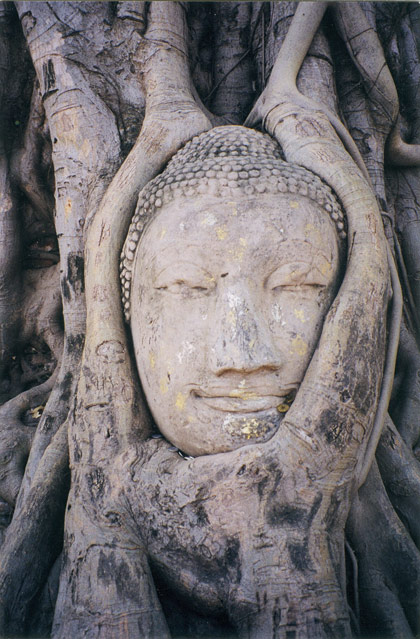
In Ayuthaya, the ancient capital of Thailand, I saw this buddha head in the roots of a tree.
It was a strange place. You took a boat ride from Bangkok along the Chao Praya River and a few hours later, you were touring the ruins of a temple. Most of the statues had their heads cut off, probably by robbers. I wondered where those granite heads are now. At the British Museum, there are so many statues in the Egyptian section you’ll get dizzy from the energy they emit. Somebody — perhaps somebody like notorious Lord Elgin — must have had the audacity and worse to transport them from the temples in Egypt. Will they ever be returned to their rightful owner and home?
I do not go to these places just to see and watch. I make it a practice to do Tai Ji, meditation or Qigong in mountains, temples, pyramids, stone circles, even museums. The guards may object and others will gawk at you, but there’s no law against it, as far as I know. At the Metropolitan Museum in New York City
there’s the temple of Dendur at the Egyptian section. If you have the time, and are able to ignore the crowd, try doing meditation inside of it.
I’ve done qigong at the head of a huge scarab at the London museum. I did not notice a young girl following my movements. She introduced herself later. She was a German visiting London. I have also done a whole Tai ji set (108) in the Parthenon in Greece and at the foot of the Eiffel Tower in Paris. The island of Ephesus isn’t bad either. On top of a mountain there’s Mother Mary’s stone church that is a place of pilgrimage. Not to forget the Tor in Glastonbury. The energy is very palpable in some of them. Next time, if anybody is interested, I will post more photos.
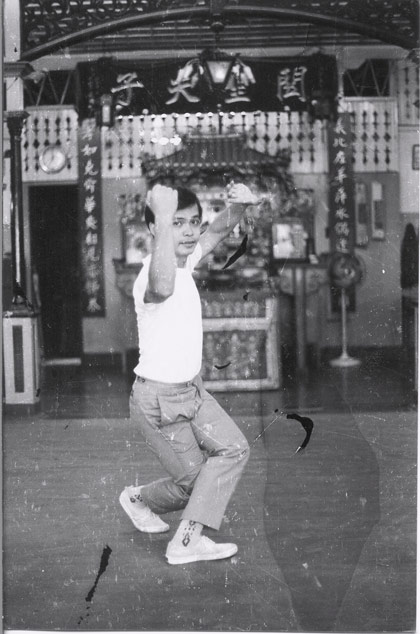
A posture from the rare form called Wat Let — I do not know what it means — I learned from GM Lao Kim back in 1968. I do not know if the old master taught it to anybody else. It was a strange but beautiful set, basically following a straight, linear direction with occasional diagonal side-stepping. It had diverse movements and stances, some of them awkward.
I was in my late 20s at the time. I had a wealth of energy and curiosity. Master Lao had the patience to teach me all those forms. Often, he would just sit in one corner reading a Chinese-language newspaper and smoking a cigarette. I did a lot of repetitions. There was nobody else in the Buddhist temple in Binondo, Manila, the heart of Chinatown. He spoke no English or Tagalog, I spoke no Chinese. But we communicated quite well. It was a different language we used altogether: the poetry of movement and stillness.
Hi Shifu,
It’s so nice to see your photos and annotations. Wonderful photography! You always capture the essence of a place. The Cave of Jacob brings back fond memories of Banahaw.
K
Dear Mr. Rene Navarro,
Thank you for sharing your thoughts. Your achievement is inspirational. I am looking forward to have the privilege of attending one of your workshops.
Very truly yours,
Annabelle Herter
Lovely photos Rene. Thanks for sharing them.
Thank you, Annabelle. I am happy to hear that you are a Filipino, a poli sci and law graduate of San Carlos University in Cebu City. I have visited Cebu many times. When I was 20, I attended a college editors’ conference there. On a few occasions in the late 80s, I studied arnis de mano in Barrio Labangon and Bantayan Island. The journey is often serendipitous. Sometimes along the road we discover something we did not expect or we were not looking for. We are gifted with a rare insight into a a different life, we switch paths in middle-age and we embrace a different world. Keep in touch, kababayan. Ingat, Rene